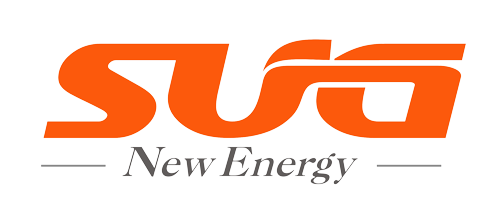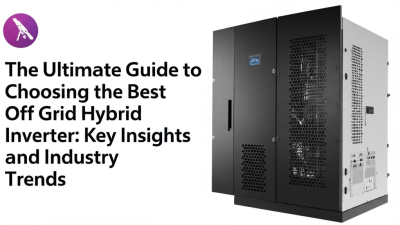
In recent years, the demand for renewable energy solutions has surged, leading to a significant increase in the popularity of Off Grid Hybrid Inverters. According to a report by Allied Market Research, the global hybrid inverter market is projected to reach $19.3 billion by 2027, driven by the growing need for energy independence and sustainability. Off Grid Hybrid Inverters play a pivotal role in enabling users to harness solar power while ensuring a reliable energy supply through battery storage. However, choosing the right Off Grid Hybrid Inverter can be daunting due to the myriad of options available and the varying features they offer. Understanding the common problems associated with these inverters, such as compatibility issues and efficiency challenges, is crucial for making an informed decision. This guide will explore key insights and current industry trends to help you navigate the complexities of selecting the best Off Grid Hybrid Inverter for your needs.

Off grid hybrid inverters are revolutionary devices designed to provide efficient power management for homes and facilities that are not connected to the traditional electrical grid. These inverters blend solar energy, battery storage, and sometimes conventional generators into a cohesive system that maximizes energy usage and minimizes reliance on external sources. They capture solar power during sunny days, store excess energy in batteries for nighttime use, and seamlessly switch to generators when necessary, ensuring a continuous power supply.
Key components of off grid hybrid inverters include the inverter itself, which converts direct current (DC) from solar panels and batteries to alternating current (AC) for household use, and the battery management system, which regulates charging and discharging cycles to extend battery life. Additionally, these systems often feature advanced monitoring technology, allowing users to track energy consumption and production levels in real-time. By integrating renewable energy sources with advanced technology, off grid hybrid inverters offer a sustainable solution for energy independence while reducing environmental impact.
| Feature | Description | Importance | Current Trends |
|---|---|---|---|
| Power Output | The amount of power an inverter can provide, usually measured in watts. | Crucial for determining size and capability to meet energy needs. | Increasing demand for higher capacity inverters. |
| Input Voltage | The voltage range the inverter can accept from solar panels or batteries. | Essential for compatibility with solar panel systems. | Trend towards flexibility with multi-input options. |
| Efficiency Rate | Percentage of input power converted to output power. | Higher efficiency means less energy is wasted. | Focus on products with 90% or higher efficiency. |
| Waveform Type | The output waveform: Pure Sine Wave or Modified Sine Wave. | Pure Sine Wave is better for sensitive electronics. | Growing preference for pure sine wave inverters. |
| Battery Type Compatibility | Compatibility with various battery types like Lead-Acid, Lithium-ion, etc. | Key for ensuring optimal performance and lifespan. | Shift towards lithium-ion integration due to performance. |
| Safety Features | Includes protections against overvoltage, overload, and short circuit. | Essential for safeguarding equipment and users. | Innovations in smart safety technology becoming prevalent. |
The off-grid hybrid inverter market is poised for significant growth, driven by technological advancements anticipated by 2025. According to market research, the global generator sales market size is projected to increase from $33.56 billion in 2025 to $49.56 billion by 2032, reflecting a robust compound annual growth rate (CAGR) of 5.73%. This growth underscores a rising demand for energy solutions that offer sustainable and efficient off-grid power systems.
Moreover, the portable power station market in the U.S. is experiencing an upward trend, with projections indicating a climb from $299.4 million in 2025 to $504.95 million by 2032, or an annual growth rate of 8.04%. As consumers seek reliable power alternatives, innovations in off-grid solar photovoltaic panels and hybrid power systems will play a pivotal role in meeting these evolving energy needs. The integration of various energy sources, including solar, wind, and biomass, within hybrid systems is expected to enhance versatility and efficiency, catering to both residential and commercial applications.
As hybrid energy solutions gain traction, industry reports indicate a 20% increase in demand by 2025. This surge is driven by advancements in technologies that integrate renewable sources, including solar and wind power. Research highlights that the global hybrid capacitor market alone is projected to grow from USD 570.7 million in 2024 to 20.5% annually until 2034, showcasing a robust appetite for energy-efficient alternatives. Additionally, the hybrid train market is expected to reach approximately USD 43.3 billion by 2034, further evidencing the shift towards hybrid systems across various sectors.
Tips: When selecting a hybrid inverter, prioritize compatibility with multiple energy sources and assess its efficiency in real-time energy management. Consider models that offer advanced features like smart grid connectivity to stay ahead in an evolving market. It's also advisable to stay updated on regulatory changes, as they can impact the feasibility and incentives associated with hybrid energy investments.
When choosing the best off-grid hybrid inverter for your specific energy needs, evaluating efficiency ratings is crucial. The global market for micro-inverters is projected to experience significant growth, expanding from $4.12 billion in 2024 to $15.4 billion by 2032, with a remarkable compound annual growth rate (CAGR) of 17.92%. This growth highlights the increasing demand for efficient energy solutions as consumers and businesses alike seek to reduce reliance on grid power, particularly in regions facing electrical shortages exacerbated by geopolitical issues and extreme weather patterns.
Understanding efficiency ratings can aid greatly in selecting the right inverter. High efficiency ensures minimal energy loss during conversion from DC to AC, which is particularly vital amidst rising electricity costs and climate challenges. As more manufacturers innovate and offer advanced technologies aimed at improving energy output, it becomes essential to compare these ratings. Factors such as load management and compatibility with renewable energy sources should also be considered, allowing users to maximize their investment in off-grid systems while ensuring consistent energy availability.
As the demand for sustainable energy solutions grows, integrating renewable energy sources with off-grid hybrid inverters becomes crucial for maximizing savings and environmental benefits. These inverters not only manage traditional power sources but also optimize the use of solar panels, wind turbines, and other renewable technologies. By harnessing clean energy, users can significantly reduce their reliance on fossil fuels, leading to lower electricity bills and a smaller carbon footprint.
Moreover, modern off-grid hybrid inverters offer advanced features such as smart load management and battery storage integration, enhancing overall efficiency. When combined with solar energy, these systems can store excess power generated during sunny days, allowing for usage during peak hours or during cloudy periods. This synergy not only capitalizes on natural energy sources but also ensures a consistent power supply, promoting self-sufficiency and resilience in energy consumption. As technology evolves, the integration of renewable sources with hybrid inverters is set to play a transformative role in sustainable living, empowering individuals and communities to embrace green energy solutions.